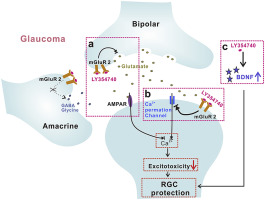当前位置:
X-MOL 学术
›
Neuropharmacology
›
论文详情
Our official English website, www.x-mol.net, welcomes your
feedback! (Note: you will need to create a separate account there.)
Group II metabotropic glutamate receptor agonist promotes retinal ganglion cell survival by reducing neuronal excitotoxicity in a rat chronic ocular hypertension model.
Neuropharmacology ( IF 4.6 ) Pub Date : 2020-02-23 , DOI: 10.1016/j.neuropharm.2020.108016 Qian Li 1 , Ruiri Jin 2 , Shenghai Zhang 3 , Xinghuai Sun 1 , Jihong Wu 1
Neuropharmacology ( IF 4.6 ) Pub Date : 2020-02-23 , DOI: 10.1016/j.neuropharm.2020.108016 Qian Li 1 , Ruiri Jin 2 , Shenghai Zhang 3 , Xinghuai Sun 1 , Jihong Wu 1
Affiliation

|
Glaucoma, the second leading cause of irreversible blindness worldwide, is characterized by the selective death of retinal ganglion cells (RGCs). The group II metabotropic glutamate receptor (mGluR II) activation has been linked to RGC survival, however, the mechanism by which it promotes neuronal survival remains poorly defined. In the present work, we show that extracellular application of LY341495, an mGluR II antagonist could increase the RGC firing frequency, suggesting that activation of mGluR II by endogenously released glutamate could modulate RGC excitability. LY354740, an mGluR II agonist, significantly decreased RGC excitability and the reduced presynaptic excitatory inputs and post-synaptic Ca2+-permeable currents mediated the LY354740-induced effects. By using a well-characterized in vivo male Sprague-Dawley rat glaucoma model, we further demonstrate that in the early stage of experimental glaucoma, the expression of mGluR II dimer-formed protein was significantly reduced, and pre-activation of mGluR II by intravitreal injection of LY354740 before establishment of the glaucoma model could effectively reduce excitatory inputs, thereby reversing hyperexcitability induced by elevated intraocular pressure. Furthermore, LY354740 could increase the expression level of brain-derived neurotrophic factor in the glaucomatous retinas, further protecting RGCs. Our study indicates that the abnormal expression of mGluR II may accelerate RGC apoptosis in glaucoma, and demonstrates that mGluR II agonist LY354740 can be used as a novel method to counter RGC apoptosis in glaucoma.
中文翻译:

II型代谢型谷氨酸受体激动剂可通过减少大鼠慢性高眼压模型的神经元兴奋性毒性来促进视网膜神经节细胞的存活。
青光眼是全球不可逆失明的第二大主要原因,其特征是视网膜神经节细胞(RGC)选择性死亡。II组代谢型谷氨酸受体(mGluR II)的激活与RGC的存活有关,但是,其促进神经元存活的机制仍然不清楚。在目前的工作中,我们表明细胞外应用mGluR II拮抗剂LY341495可以增加RGC的触发频率,这表明内源性释放的谷氨酸激活mGluR II可以调节RGC的兴奋性。LY354740,一种mGluR II激动剂,显着降低了RGC的兴奋性,并降低了突触前兴奋性输入和突触后Ca2 +的可渗透电流介导了LY354740诱导的作用。通过使用特征明确的体内雄性Sprague-Dawley大鼠青光眼模型,我们进一步证明,在实验性青光眼的早期,mGluR II二聚体形成蛋白的表达显着降低,并且在建立青光眼模型之前通过玻璃体内注射LY354740来预激活mGluR II可以有效减少兴奋性输入,从而逆转眼压升高引起的过度兴奋。此外,LY354740可以增加青光眼视网膜中脑源性神经营养因子的表达水平,从而进一步保护RGC。我们的研究表明,mGluR II的异常表达可能会加速青光眼中RGC的凋亡,并表明mGluR II激动剂LY354740可以用作对抗青光眼中RGC凋亡的一种新方法。mGluR II二聚体形成蛋白的表达显着降低,在青光眼模型建立之前通过玻璃体内注射LY354740预先激活mGluR II可有效减少兴奋性输入,从而逆转眼压升高引起的过度兴奋。此外,LY354740可以增加青光眼视网膜中脑源性神经营养因子的表达水平,从而进一步保护RGC。我们的研究表明,mGluR II的异常表达可能会加速青光眼中RGC的凋亡,并表明mGluR II激动剂LY354740可以用作对抗青光眼中RGC凋亡的一种新方法。mGluR II二聚体形成蛋白的表达显着降低,在青光眼模型建立之前通过玻璃体内注射LY354740预先激活mGluR II可有效减少兴奋性输入,从而逆转眼压升高引起的过度兴奋。此外,LY354740可以增加青光眼视网膜中脑源性神经营养因子的表达水平,从而进一步保护RGC。我们的研究表明,mGluR II的异常表达可能会加速青光眼中RGC的凋亡,并表明mGluR II激动剂LY354740可以用作对抗青光眼中RGC凋亡的一种新方法。在青光眼模型建立之前通过玻璃体内注射LY354740预先激活mGluR II可以有效减少兴奋性输入,从而逆转眼压升高引起的过度兴奋。此外,LY354740可以增加青光眼视网膜中脑源性神经营养因子的表达水平,从而进一步保护RGC。我们的研究表明,mGluR II的异常表达可能会加速青光眼中RGC的凋亡,并表明mGluR II激动剂LY354740可以用作对抗青光眼中RGC凋亡的一种新方法。在青光眼模型建立之前通过玻璃体内注射LY354740预先激活mGluR II可以有效减少兴奋性输入,从而逆转眼压升高引起的过度兴奋。此外,LY354740可以增加青光眼视网膜中脑源性神经营养因子的表达水平,从而进一步保护RGC。我们的研究表明,mGluR II的异常表达可能会加速青光眼中RGC的凋亡,并表明mGluR II激动剂LY354740可以用作对抗青光眼中RGC凋亡的一种新方法。
更新日期:2020-02-23
中文翻译:

II型代谢型谷氨酸受体激动剂可通过减少大鼠慢性高眼压模型的神经元兴奋性毒性来促进视网膜神经节细胞的存活。
青光眼是全球不可逆失明的第二大主要原因,其特征是视网膜神经节细胞(RGC)选择性死亡。II组代谢型谷氨酸受体(mGluR II)的激活与RGC的存活有关,但是,其促进神经元存活的机制仍然不清楚。在目前的工作中,我们表明细胞外应用mGluR II拮抗剂LY341495可以增加RGC的触发频率,这表明内源性释放的谷氨酸激活mGluR II可以调节RGC的兴奋性。LY354740,一种mGluR II激动剂,显着降低了RGC的兴奋性,并降低了突触前兴奋性输入和突触后Ca2 +的可渗透电流介导了LY354740诱导的作用。通过使用特征明确的体内雄性Sprague-Dawley大鼠青光眼模型,我们进一步证明,在实验性青光眼的早期,mGluR II二聚体形成蛋白的表达显着降低,并且在建立青光眼模型之前通过玻璃体内注射LY354740来预激活mGluR II可以有效减少兴奋性输入,从而逆转眼压升高引起的过度兴奋。此外,LY354740可以增加青光眼视网膜中脑源性神经营养因子的表达水平,从而进一步保护RGC。我们的研究表明,mGluR II的异常表达可能会加速青光眼中RGC的凋亡,并表明mGluR II激动剂LY354740可以用作对抗青光眼中RGC凋亡的一种新方法。mGluR II二聚体形成蛋白的表达显着降低,在青光眼模型建立之前通过玻璃体内注射LY354740预先激活mGluR II可有效减少兴奋性输入,从而逆转眼压升高引起的过度兴奋。此外,LY354740可以增加青光眼视网膜中脑源性神经营养因子的表达水平,从而进一步保护RGC。我们的研究表明,mGluR II的异常表达可能会加速青光眼中RGC的凋亡,并表明mGluR II激动剂LY354740可以用作对抗青光眼中RGC凋亡的一种新方法。mGluR II二聚体形成蛋白的表达显着降低,在青光眼模型建立之前通过玻璃体内注射LY354740预先激活mGluR II可有效减少兴奋性输入,从而逆转眼压升高引起的过度兴奋。此外,LY354740可以增加青光眼视网膜中脑源性神经营养因子的表达水平,从而进一步保护RGC。我们的研究表明,mGluR II的异常表达可能会加速青光眼中RGC的凋亡,并表明mGluR II激动剂LY354740可以用作对抗青光眼中RGC凋亡的一种新方法。在青光眼模型建立之前通过玻璃体内注射LY354740预先激活mGluR II可以有效减少兴奋性输入,从而逆转眼压升高引起的过度兴奋。此外,LY354740可以增加青光眼视网膜中脑源性神经营养因子的表达水平,从而进一步保护RGC。我们的研究表明,mGluR II的异常表达可能会加速青光眼中RGC的凋亡,并表明mGluR II激动剂LY354740可以用作对抗青光眼中RGC凋亡的一种新方法。在青光眼模型建立之前通过玻璃体内注射LY354740预先激活mGluR II可以有效减少兴奋性输入,从而逆转眼压升高引起的过度兴奋。此外,LY354740可以增加青光眼视网膜中脑源性神经营养因子的表达水平,从而进一步保护RGC。我们的研究表明,mGluR II的异常表达可能会加速青光眼中RGC的凋亡,并表明mGluR II激动剂LY354740可以用作对抗青光眼中RGC凋亡的一种新方法。











































 京公网安备 11010802027423号
京公网安备 11010802027423号